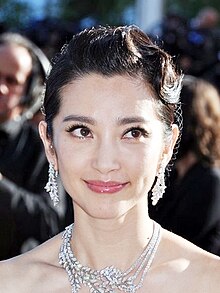Female Chinese beauty standards have become a well-known feature of Chinese culture. A 2018 survey conducted by the Great British Academy of Aesthetic Medicine concluded that Chinese beauty culture prioritizes an oval face shape, pointed, narrow chin, plump lips, well defined Cupid's bows, and obtuse jaw angle.[1] The importance of feminine beauty in China has been deeply ingrained into the culture: historically, a woman's livelihood was often determined by her ability to find an eligible husband, a feat aided by fitting into the cultural ideals of beauty.[2]
Black hair that is long, thick and shiny is seen as particularly beautiful among Chinese women.[3][4] Similarly, pale, ivory skin, and a slim body figure have historical implications as being a physical representation of wealth and affluence. More recently, however, tan skin has emerged as the preferred beauty ideal among some younger Chinese women, who view their tan skin as healthier and more attractive than pale skin.[5]
A relatively new ideal ingrained into Chinese culture consists of the notion of having a double eyelid. The term double eyelid refers to the prominent crease natural to approximately 66.7% and 83.1% of Chinese women.[6] For the minority that does not naturally have them, this look can be achieved temporarily by using specific cosmetic products such as tape or glue. A permanent option is to undergo a procedure titled blepharoplasty, which utilizes cosmetic surgery to reshape the eyelid.[7]


- ^ Samizadeh, Souphiyeh; Wu, Woffles (2018-07-09). "Ideals of Facial Beauty Amongst the Chinese Population: Results from a Large National Survey". Aesthetic Plastic Surgery. 42 (6): 1540–1550. doi:10.1007/s00266-018-1188-9. ISSN 0364-216X. PMC 6280816. PMID 29987486.
- ^ "<italic>The Life of Moses Coit Tyler</italic>. By <sc>Howard Mumford Jones</sc>. Based upon an Unpublished Dissertation from Original Sources by <sc>Thomas Edgar Casady</sc>. (Ann Arbor: University of Michigan Press. 1933. Pp. xi, 354. $2.50.)". The American Historical Review. 1934. doi:10.1086/ahr/40.1.152. ISSN 1937-5239.
- ^ Cite error: The named reference
Eberhard 2006 p. 163was invoked but never defined (see the help page). - ^ Godley, Michael R. "The end of the queue: hair as symbol in Chinese history". East Asian History (8): 53–72.
- ^ Cite error: The named reference
Lim2021was invoked but never defined (see the help page). - ^ Lu, Ting Yin; Kadir, Kathreena; Ngeow, Wei Cheong (2017). "The Prevalence of Double Eyelid and the 3D Measurement of Orbital Soft Tissue in Malays and Chinese". Scientific Reports. 7 (7): 14819. Bibcode:2017NatSR...714819L. doi:10.1038/s41598-017-14829-4. PMC 5665901. PMID 29093554.
- ^ Rohrich, Rod J.; Coberly, Dana M.; Fagien, Steven; Stuzin, James M. (2004). "Current Concepts in Aesthetic Upper Blepharoplasty". Plastic and Reconstructive Surgery. 113 (3): 32e–42e. doi:10.1097/01.PRS.0000105684.06281.32. ISSN 0032-1052. PMID 15536308. S2CID 42442451.